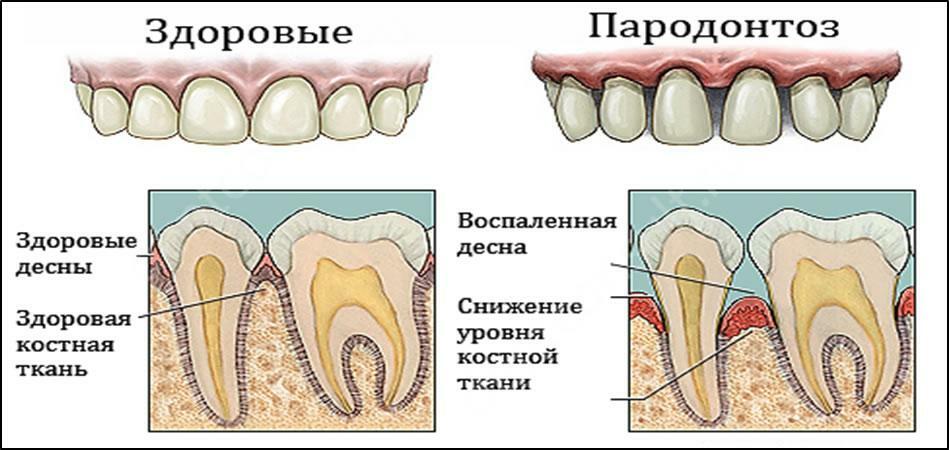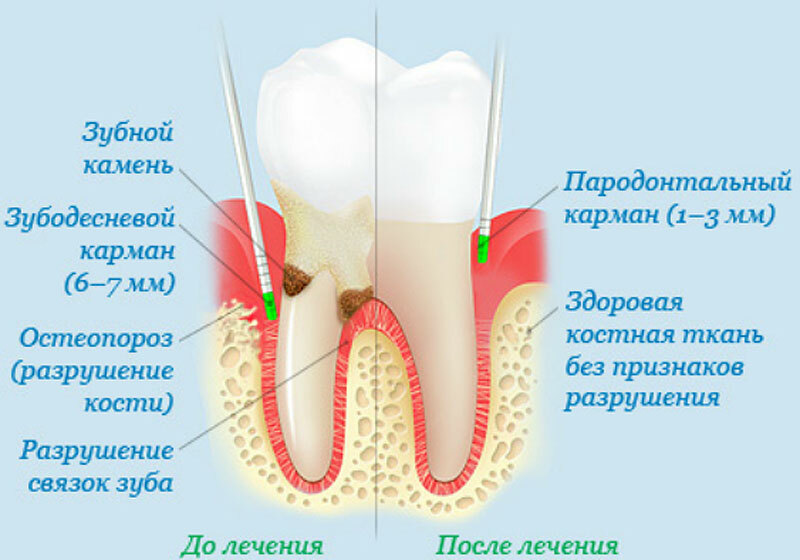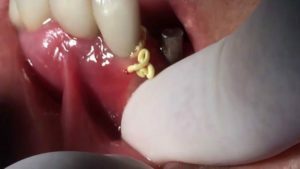 The term "alveolar pyorrhea" is not very successful, because it characterizes only one of the manifestations of the disease, and even if it is sufficiently neglected.
The term "alveolar pyorrhea" is not very successful, because it characterizes only one of the manifestations of the disease, and even if it is sufficiently neglected.
What is pyorrhea of teeth? Pyorrhea is the secretion of pus from the periodontal pockets. They are also called periodontal, or alveolar, and represent small annular cavities - spaces between the tooth's neck and the edge of the gum.
Normally their volume is small, but with the onset of inflammatory process in this area, a purulent detritus is formed, which is released to the outside. Hence the name "pyorrhoea", literally meaning "suppuration".
By terms: alveolar pyorrhea, amphodontosis, periodontal disease, the same condition is implied. It is also referred to as:
- by periodontitis;
- is paradentitis;
- by periodontalysis;
- with periodontal disease;
- by polyalveolysis;
- with premature alveolar atrophy;
- by Foshar's disease.
Disease, cardinally different from periodontitis.
Intensification of suppuration occurs:
- when squeezing out pus;
- when it is exhausted.
The first option is a mechanical pressure on the teeth when they are closed or during chewing.
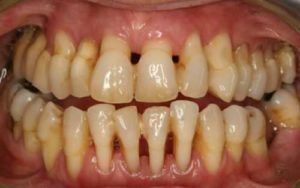
The second mechanism is the appearance of a suction effect due to variations in air pressure in the oral cavity. It is caused by a change in the volume of the oral cavity - a sharp increase in it, followed by a sharp decrease.
The effect is created due to intensive work of the muscles of the lips, cheeks, tongue and palate with:
- mouth rinsing;
- the presence of habits to draw the cheeks, drive saliva in the mouth, often and spontaneously spit;
- emotionally-turbulent verbal expression of feelings.
In far-reaching cases, pyorrhea manifests itself even in calm conversations.
content
- What happens to the teeth and gums
- Etiology and pathogenesis
- symptoms and course amphodontosis
- Stages and forms
- disease Phase
- second phase
- third phase
- fourth phase
- complications and consequences
- Diagnostics amphodontosis
- Therapies
- Therapeutic
- Orthopedic
- Physiotherapeutic
- Surgical
- Treatment of pyorrhea in a popular way
- Prognosis and prevention
What happens to the teeth and gums
Pomisuppuration of a putrid odor characteristic mouth amphodontosis expressed loosening teeth( due to weakening of the ligaments system between their holes and necks).
But the main symptom is the inevitably growing bare necks due to the slow atrophy of the tissue of the socket. 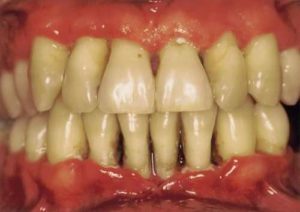
The process is initially aseptic. But at the stage of pronounced destruction of the lunar structures, the pathogenic microbial flora that inhabits the mouth develops with the development of inflammation and the formation of a purulent discharge.
Pus, melting the gum tissue, further accelerates their atrophy and promotes:
- their bleeding and swelling;
- appearance in the gums of unpleasant sensations, and then pains;
- increase in precariousness.
So parodontosis acquires the features of periodontitis.
Etiology and pathogenesis of
The main etiologic factor for the onset of atrophic process in gingival structures is the inadequacy of microcirculation in them( arterial blood supply, venous and lymphatic outflow).
It can be both genetically determined, and have quite specific reasons in the form:
- sclerosing alveolar arterioles diseases;
- presence of a neurogenic pathology;
- of hypovitaminosis( vitamin C, or other groups of vitamins).
The starting moment of the beginning of the chain of processes leading to periodontitis is the change in the acid-base balance of saliva towards the increase of acidity. 
The reason for the pH change is the availability:
- of certain food addictions( excessive consumption of sugar and sweet in general);
- habits of smoking tobacco;
- metabolic diseases of either a general nature( diabetes mellitus, hypothyroidism, gout), or private for the oral cavity( salivary gland diseases and similar conditions).
Changing the pH of the saliva to the acid side leads to:
- activation of its own pathogenic microflora of the oral cavity;
- low degree of resistance to it from the side of gingival tissue;
- formation of stone.
Symptoms and course of amphodontosis
Depending on the set of causes, the disease can have both uncomplicated and complicated( if untreated - neglected).
In the first variant, the predominant symptoms are:
- , the overgrowth of teeth( initially the cervical zone and then the roots) over time;
- corresponding to the degree of exposure pathological mobility( steadily increasing and terminating with loss of teeth from the wells);
- is an excessive( not painful) sensitivity of the tissues of both teeth and gums in the neck area.
In the second, in addition to the standard set of symptoms, there are symptoms of purulent process in the tissues of the gums in the form of them:
- puffiness;
- soreness;
- of bleeding;
- suppuration from the alveolar pockets.

Unlike periodontitis for periodontal disease, an atypically isolated lesion of one or two adjacent teeth - the height of the gum decreases evenly for the entire width of the dentition.
Pathology for a long time has an aseptic-atrophic character: the teeth retain a high degree of fixation for a long time, deposits of scanty, alveolar pockets of unexpressed depth, gums do not have hyperemia.
Detachable from the gingival pockets at first absent, then, having appeared, has a serous character, and only in the late stages of the disease - it becomes purulent( with the attachment of a bacterial infection).
Stages and forms of the disease
According to the data of pathological anatomy, the disease is characterized by the passage of four phases.
The first phase of
In the first, proceeding without special symptoms, especially sensitive patients pay attention to the dentist for the presence of paresthesias - burning, itching, pulsating, bursting sensations in the gums.
Visual inspection of the pathology at this stage does not detect. But the radiography already reveals the primary dystrophy of the tissues of the alveolar processes - a decrease in the height of the wells from the almost imperceptible at the edges to a quarter of the root length.
The second phase of
The second phase is the radiographically established loss of the alveolar margins to half the length of the tooth root.
Clinically manifested:
- exceeding the gingival pockets of depth of 2 mm;
- discharge from them with a slight pressure on the gingival margin of a small amount of exudate( first serous, and then - purulent);
- rapid increase in the mass of the stone.
Complaints of patients either are absent or do not differ from those that appeared in the first phase. Later, the sensations of the presence of an adhesive coating on the surface of the teeth in the mornings and the appearance of their mobility are added, while the dentist does not reveal mobility. Perhaps the appearance of bleeding gums with mechanical action on them: biting hard bread, cleaning.
The third phase of
The third phase is actually the clinic of the disease with all its characteristic symptoms:
- deepening of the gingival pockets with suppuration of them;
- exposure of the tooth necks;
- teeth dislocation and increase their mobility;
- by increasing the value of the interdental spaces.
The loss of bone tissue in the wells is more than 2/3 of the length of the tooth root.
The fourth phase of
In the fourth phase of periodontal disease, the roots are completely separated from the hole, their retention is prevented only by the retention by soft gingival tissues - a symptom of balloting of the teeth appears.
The rate of transition of the previous phase to the next, different for each of the patients, is dependent on the general and local causes that led to periodontal disease.
Complications and consequences of
Consequences of untreated early periodontitis are both defects in the oral cavity of the cosmetic-aesthetic plan( in the form of nude roots with suppuration from the alveolar cavity and the corresponding putrefactive odor), and obstruction of chewing and speech( due to the weakness of the teeth).
Foci of pain can also become a hotbed of a dangerous infection for the body, causing complications in the oral cavity, namely education:
- abscess;
- of osteomyelitis and other suppurative conditions.
In addition, there is sensitization of the body with the possibility of development in the future as allergic, infectious, and infectious-allergic conditions.
Diagnosis of amphodontosis
In addition to the visually observed atrophy of the gingival margin and dental cells in amphodontosis, there is a parallel similar process in the depth of the gingival tissues, which is fixed during X-ray monitoring of the patient.
X-ray reveals signs of sclerosis of bone tissue of alveolar processes in the form of a fine-meshed structure with osteoporosis foci and narrowing of bone marrow spaces. With the evenness of the decrease in the height of the interdental septa with the loss of bone tissue, cortical plates are preserved.
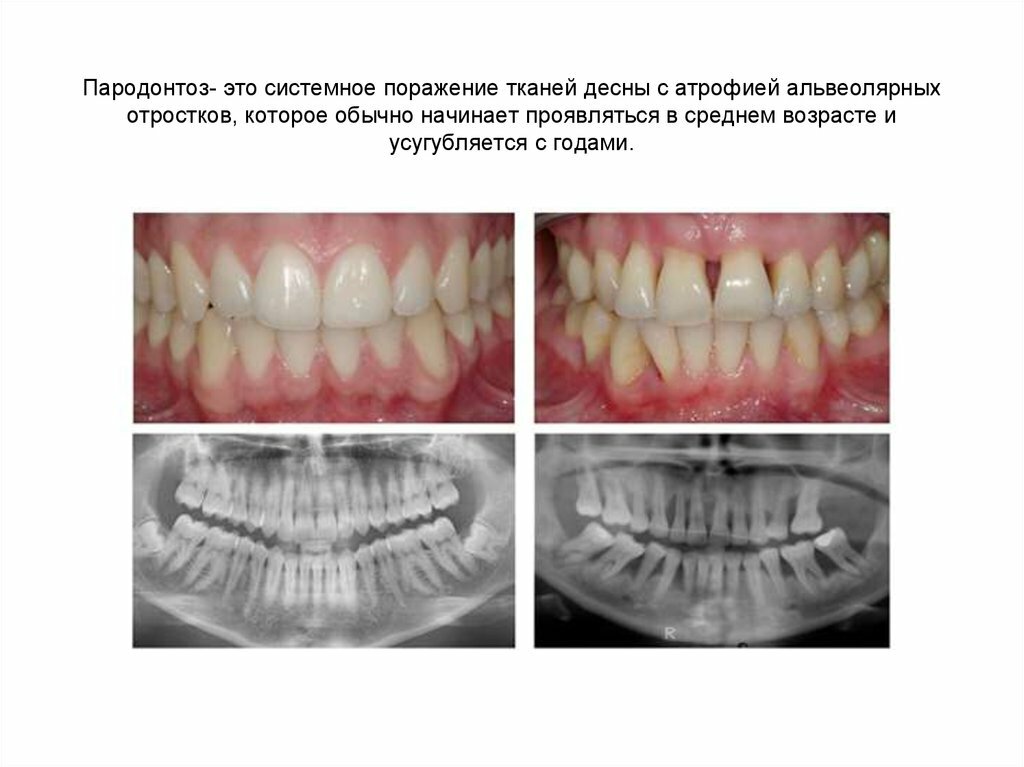
A useful addition to the radiographic method of detailed examination of the structure of the jaw bone is the methods of MRI and CT.
In the presence of a systemic pathology, which aggravates the course of the disease, the target methods of investigation are used and specialists of the corresponding profiles are involved.
Treatment methods
The complexity of the treatment depends on the neglect of the disease. It is possible to distinguish several treatment methods depending on the stage of the disease.
Therapeutic
Therapeutic methods are applicable at the initial stages of the disease and are as follows:
- elimination of mechanical causes that support the existence of the disease;
- anti-inflammatory and wound healing treatment;
- enhance the body's defenses;
- maintenance of the oral cavity in the achieved satisfactory state.
The first group of measures includes:
- removal from the oral cavity of teeth that are not subject to restoration, subgingival and supragingival calculi that do not satisfy their intended use for prostheses;
- professional cleaning of teeth with their polishing, with grinding of problem areas;
- treatment, sealing and refilling of carious teeth.
Orthopedic
The orthopedic component of conservative therapy at this stage includes.
- hardening of mobile teeth by splinting;
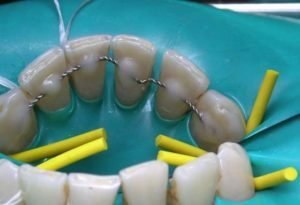
- correction of inadequate bite;
- rationalizing prosthetics.
The condition of pathologically deepened alveolar pockets deserves special attention - surgical scraping of their contents: stone, necrotic tissues, granulations.
With a shallowly entered process, this allows to improve the periodontal trophism, to revitalize and expand the capillary network, to stimulate the appearance of new granulations with the safe healing of microdefects.
This tactic shows the use of topical medications: cauterizing, astringent, disinfectant( solutions of Piotsida, Resorcinum, furacilin and the like).
Physiotherapeutic
The use of methods of physiotherapy( darsonvalization and UHF locally), rational vitamin and tissue therapy promotes the rapid healing of damaged tissues.
Surgical
Restoration of the function of seriously affected by the launched periodontitis of tissues requires the use of surgical methods of healing followed by treatment with therapeutic methods.
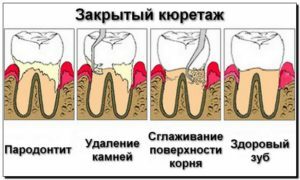 The essence of the Znamensky( or Junger-Sachs) operation is the use of a methodical curettage of the gingival pockets( according to a strictly verified scheme, with a single treatment of a certain number of teeth in each category).
The essence of the Znamensky( or Junger-Sachs) operation is the use of a methodical curettage of the gingival pockets( according to a strictly verified scheme, with a single treatment of a certain number of teeth in each category).
The curettage is carried out by first removing the hard deposits from the root surfaces, then scraping the opposite walls of the pocket is performed to excise the granulation and epithelial tissue sprouting deep into the interior.
With full dental set, a patient needs 10 to 15 visits to handle all the curettage required.
Widmann-Neumann's surgery assumes the same goal, but the difference is in peeling the mucosal-periosteal flap from the vestibular surface of the gum to create broad access to the edge of the alveolar ridge. Thus, it becomes possible to visually inspect the zone and analyze the situation in the operated area for:
- the depth and condition of the alveolar cells( bone destruction level) and the cervical areas;
- character and capacity of the zwotlock deposits;
- availability and degree of development of granulations;
- strength of the contact of teeth with their tissue environment and other important factors.

The advantage of the method lies in the comparative simplicity of the operation, the disadvantage is the excessive traumatization of tissues with the inability to preserve the structures that remain intact in the Znamensky-Junger-Sachs approach.
The indication for the application of the Widmann-Neumann technique is the onset of the second phase of periodontal disease, when applied in the third phase, the risk of rapid tooth loss is high due to the dangerous degree of loosening.
The method of gingivectomy consists in strengthening the necks with a dense ring of scar tissue that results from the removal of the edges of the gums to the deepest level of the pockets( their bottom) or the excision of their walls - as a result, the gingival pockets as a structure cease to exist. Further, the roots are freed from the stone.
The method of gingivotomy - of dissection of gingival pockets with linear incisions is not very effective because of their conservation.
Research and implementation of new methods for the plasticization of lost tissues using the substitute materials, membranes, cell cultures stimulating the regeneration activity: stem cells, fibroblasts and the like continue. 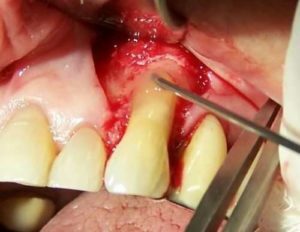
All surgical procedures require the use of local tissue exposure and physiotherapeutic treatment in the postoperative period for the early healing of the operated area.
In the presence of a systemic pathology of the organism, conducive to the existence of periodontal disease, its treatment is carried out.
Another measure of keeping the mouth in good condition is retraining the patient during the treatment of personal hygiene.
Treatment of pyorrhea in a popular way
Traditional medicine recipes as hemostatic, cauterizing and disinfectant for rinses and dental applications with bleeding gums or inflammatory phenomena in them can help only at the stages of primary periodontitis.
In case of a long-gone disease, they should not be used on their own to avoid the loss of time for full-fledged professional treatment.
The same properties of medicinal raw materials are also applicable in the postoperative period and for the prevention of amphodontosis. In any case, their use is only possible with the approval of a dentist.
Forecast and Prevention
Given the increased general and hygienic culture, the creation of new methods and materials for use in dentistry( in particular, in gingivoplasty), the prognosis for the treatment of periodontal disease is most often favorable.
Preventive measures include counseling the dentist with regular correction of emergent situations, treatment of problematic teeth, the use of orthodontic devices and adherence to the recommendations of a specialist.
The upbringing of oral hygiene skills since childhood, timely treatment of somatic diseases, adherence to the rules of a healthy lifestyle can prevent the development of this disfiguring mouth disease.

